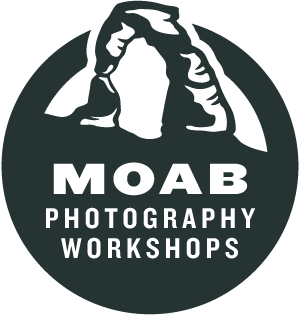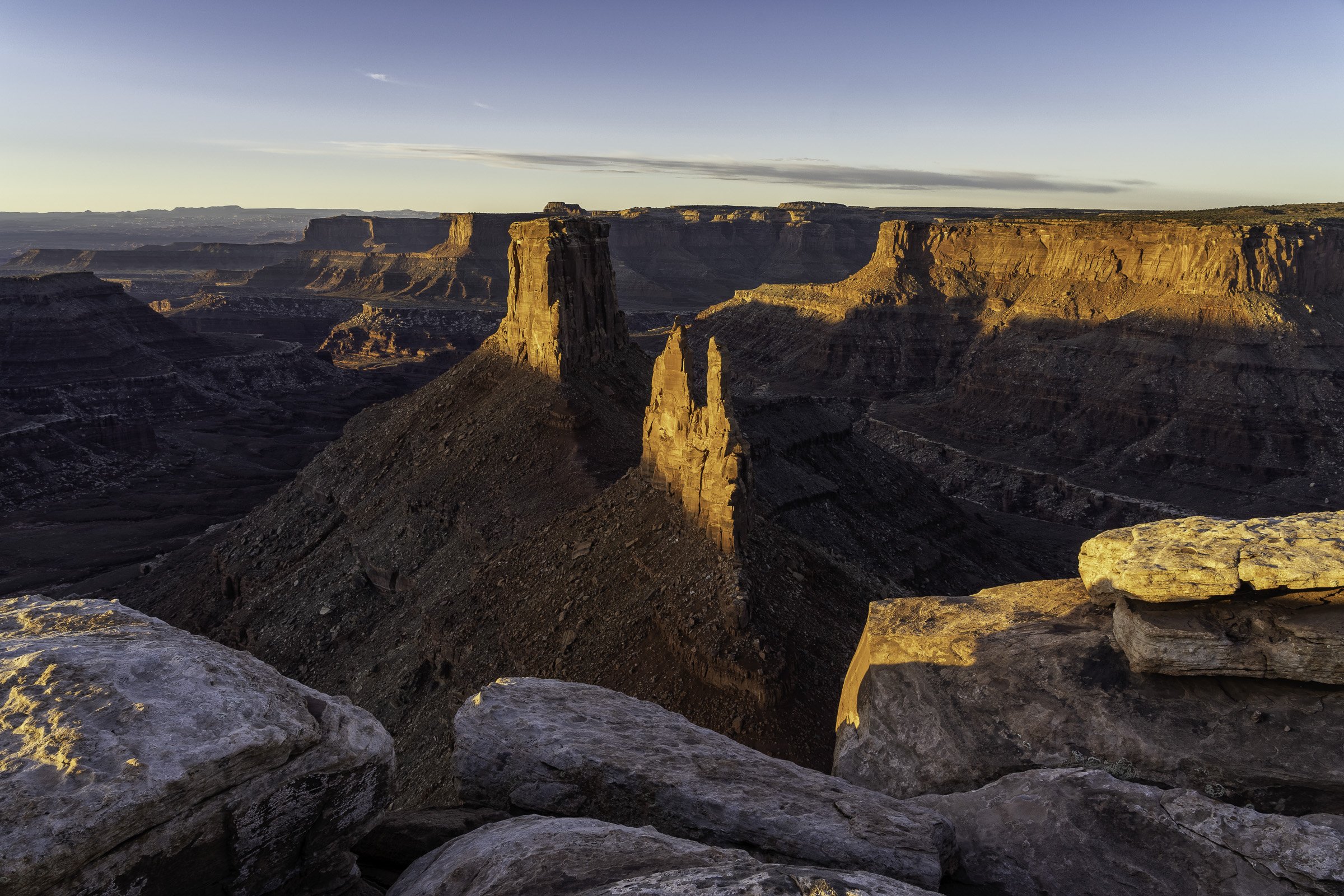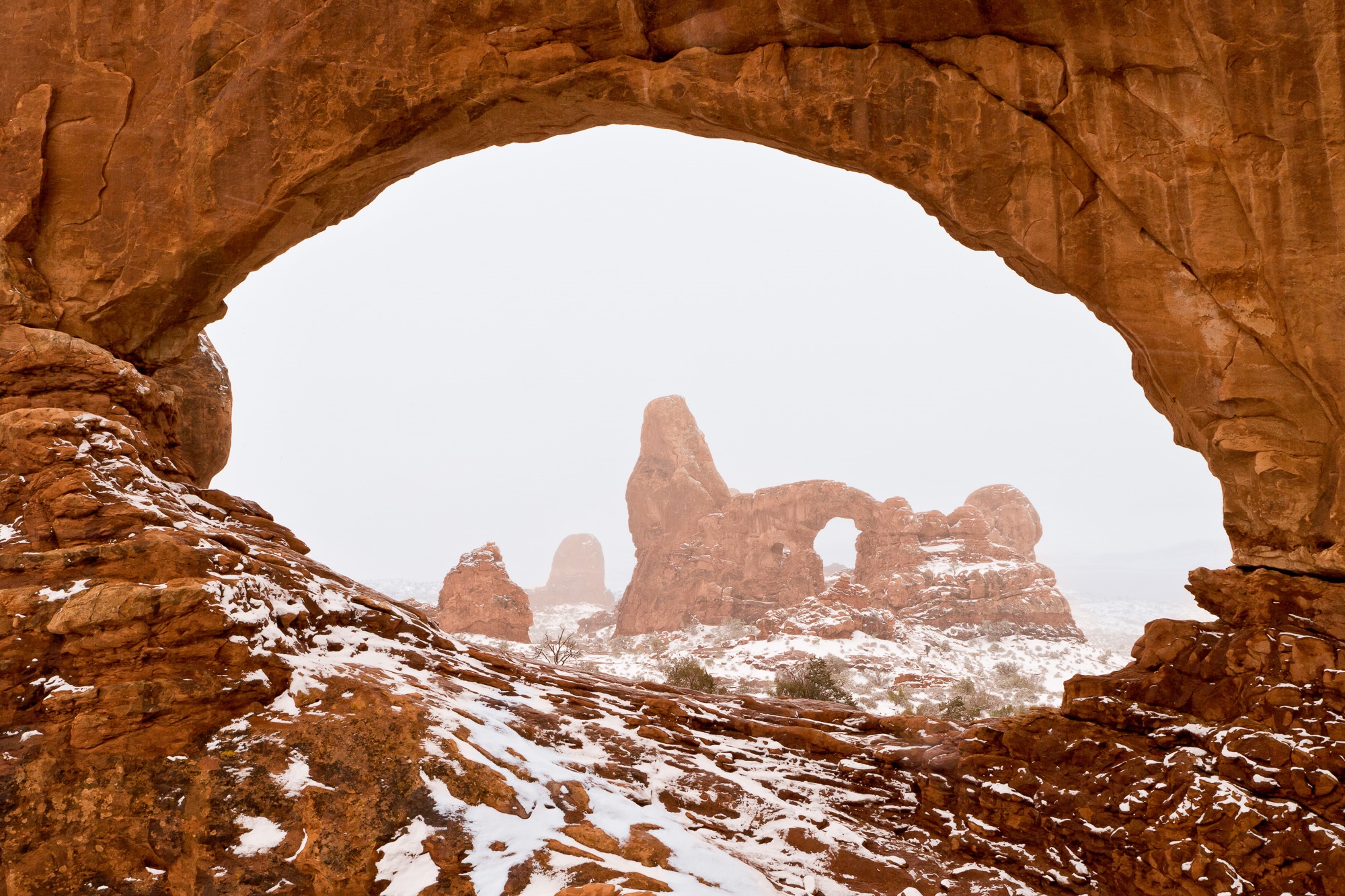One of the benefits of living in a place like Moab is that you can look out the window, assess conditions, and make a last minute decision to rally for a sunset. Such was the case recently on an unusually warm winter weekend. All day the sky alternated between partly to mostly cloudy, and at three hours before sunset a streak of blue sky spread on the western horizon below a blanket of light clouds. If it held, the sun would drop below the clouds just minutes before sunset and the sandstone would explode with vibrant shades of red, orange and yellow. Having spent the day in the house doing chores and running errands, I felt the need to escape beyond the walls. I invited Melissa and Jackson to join me for a sunset mission at Corona Arch and I was thrilled when they agreed.
We grabbed packs, threw on hiking boots, filled water bladders and were on the road within 45 minutes, arriving at the trailhead an hour and a half before sunset. I was surprised to see several cars bearing out of state plates in the parking lot. Moab locals usually get our town and trails back from the tourists in winter. This being one of the more popular hikes, we’d have to share it with a few others. As we ascended the first steep stretch of trail I looked over my shoulder and noted that the band of blue sky was quickly disappearing. My confidence in a dramatic sunset was beginning to wane.
It’s a quick hike to the arch and along the way a small, contorted juniper tree improbably sprouts from a crack in the sandstone. I’ve passed it at least a dozen times and never once considered photographing it. Today, however, it intrigued me. Melissa and Jackson continued toward the arch as I circled the tree, experimenting with various compositions. From one perspective, the sandstone appeared to form a vortex, perhaps responsible for the forces that twisted the juniper into its tortured shape. After creating a few images of the tree under the soft, diffused light I beat feet toward the arch, only to be stopped once again by yet another lovely intimate landscape.
Bowtie Arch, a pothole style arch with a small seep below supporting a surprisingly diverse hanging garden, greets hikers rounding the corner toward Corona Arch. This creates a weeping wall with patterns resembling abstract art. A small single leaf ash desperately clinging to autumn, leaves still ablaze, caught my eye. Maneuvering to a position that placed the ash in front of the weeping wall, I went to work fine tuning a composition. Colorful leaves backed by the almost monochromatic, textural sandstone provided a visual treat for my camera.
I regularly use the Peak Finder app as a photography tool, not only to learn the names of nearby mountains but more frequently to find the precise location of sunrise and sunset. I glimpsed at the western horizon and saw a hole in the clouds beginning to form. Referencing the app, I confirmed that the sun would set directly through that break in the clouds! I raced toward Corona Arch and begin scouting for compositions to the sounds of a drone flying overhead. Two men were seated directly under the arch, using the drone for selfies. Luckily, they moved out of the way but the drone continued to, well…drone, for the next 45 minutes with only a brief respite when the device required a battery change. So much for a peaceful experience in nature.
Having visited this spot at least a dozen times, I knew of a perfectly placed juniper tree that could be composed such that it filled the inside of the arch. Not knowing how long the sunset light would last, I set up my tripod and dialed in this composition. I then wandered around experimenting with other compositions through my camera’s viewfinder. On the left, a basic image of the arch rising from a sea of slickrock. To the right, a scraggly buckwheat plant that would make a wonderful foreground.
Colorful sunset clouds fill the sky behind the massive span of Corona Arch near Moab, Utah.
Returning to the original composition, I mounted my camera to the tripod, crossed my fingers and waited for the golden light I hoped would materialize. I didn’t have to wait long. Soon, a faint but noticeable glow emerged, quickly moving from pastel to neon as the entire area exploded with warm light! Working hastily, I made a few images, confirming each exposure before moving on to the other compositions. The light would ebb as the sun passed through cloud layers, then blow up again, which made for an exciting evening of photography.
Seeing what appeared to be a shadow of Corona Arch on a huge slickrock ramp behind it, I moved closer to the arch and couldn’t believe my luck. There it was, a perfect shadow! I had just enough time for two more photographs before the sun dove below the horizon. Hungry and chilled, I was tempted to pack it in but the thought of leaving the arch too early, and missing out on a colorful sky, overrode my hunger pangs. Cloud by cloud, the western sky transitioned from purplish blue, to light blue, to various shades of sherbet. As quickly as it arrived, the color faded and darkness began to fall.
We hiked out in the fading light without stopping to dig out our headlamps. The low light and lack of contrast demanded careful attention to each footstep, but we soon arrived back at the trailhead. In almost seventeen years, with more than a dozen visits to Corona Arch, this was the most spectacular light show I’ve witnessed here. Some days, it pays to look out the window and forego all responsibilities for a quick sunset hike!
Check out my guide to photographing Corona Arch, available for only $5.00 and downloadable as a PDF that can be viewed on almost any device.









